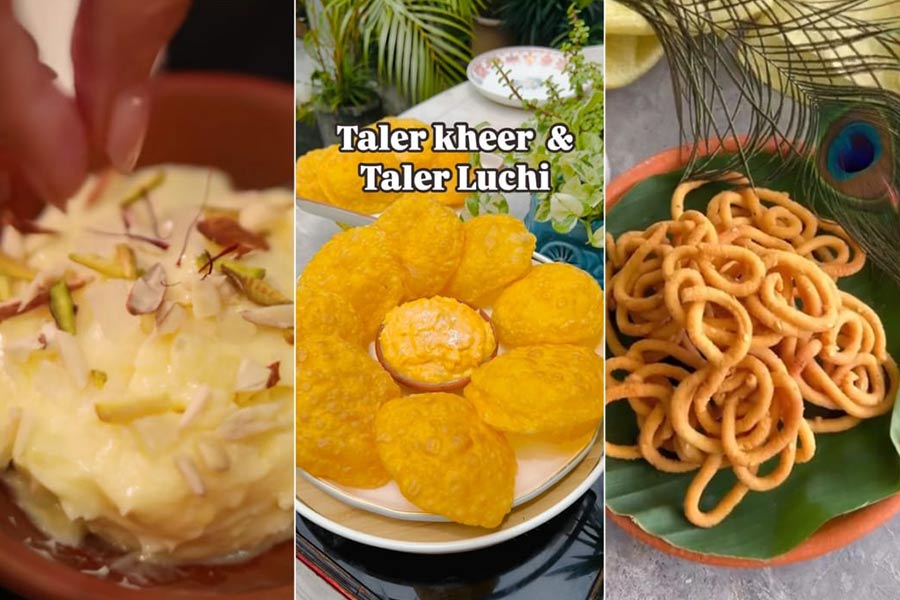Janmashtami is celebrated as the birthday of Lord Krishna, and this year it falls on August 26. The rituals of Janmashtami include offering delectable food to the deity. From the traditional Chhappan Bhog to Makhan Misri, different dishes are home-made with love and offered in different cultures. On this day, Krishna is treated as an infant/toddler and is pampered with good food and gifts. If you are celebrating Janmashtami and need some ideas for some traditional preparations, then here are five easy recipes that My Kolkata picked up from Instagram reels.
Makhan Misri for the ‘Makhan chor’
The legends of Lord Krishna stealing butter or ghee are very popular. So, offering butter in the form of Makhan Misri is also popular in many cultures across India. This offering is basically home-made butter topped with crystal sugar, dry fruits and saffron. @juhiparmar, a popular face on Indian television, has made a detailed reel showing the easiest way to make Makhan Misri at home. This is not only easy, but gets done in no time with very basic ingredients. It is sweet and buttery, and a perfect dish for Janmashtami celebration.
South India's Aval Payasam with a twist
In south India, Aval Payasam is a traditional dessert served during Janmashtami. It is made with beaten rice flakes — known as aval, chiwda or poha — milk, sugar and ghee. The aval is soaked in milk and cooked till it thickens, then sweetener like sugar or jaggery is added and flavoured with cardamom. sakarasaathamum_vadakarium adds her own touch to make this delightful sweet dish. The twist is in the form of caramel. She makes a caramel sauce and adds it to the payasam to give it a beautiful brown colour and creamy texture. Check out the full recipe from the reel and make it for your dear Gopal!
Poha Muruku — a mandatory Janmashtami snack
In south India, Poha Muruku is another popular Janmashtami snack and the festive spread is incomplete without this. It’s crispy, flavourful, and addictive, and made with poha/chiwda (flattened rice flakes), rice flour, besan (gram flour), different spices like cumin, sesame seeds, and red chili powder. It is fried in desi ghee or oil. The mixture is dropped into the oil in rings or spirals and deep-fried until golden brown. Want to make this Janmashtami special snack this year? @aruna_vijay_masterchef of MasterChef India fame shows you how to.
Bengal’s own Taaler Bora
Taaler Bora in West Bengal is a staple on Janmashtami. This classic sweet treat is little fried balls made from the pulp of the palm fruit known as taal, rice or wheat flour and shredded coconut. Sometimes jaggery or sugar is added depending upon how naturally sweet the pulp is. The mixture is shaped into small balls, deep-fried on high flame until crispy. The balls are crunchy on the outside, and sweet and soft on the inside. Taaler Bora is served as an offering to Lord Krishna and also distributed among devotees during Janmashtami. The process is a little painstaking, but the result is delicious! Learn more about this recipe and how to ace it from MasterChef India’s @oindrilabala. Watch her reel below.
Taal Kheer with Taal er Luchi — an indulgent combo
The palm fruit is used in different forms in Bengal. When ripe, the pulp is extracted and besides the taler bora, there are other recipes too that can be made using this fruit. Among them are Taaler Kheer and Taaler Luchi, which again are offered to Lord Krishna on Janmashtami. Trying his hands at this delicious combo, @rinchen_momo, who runs the Instagram food page @vlogginkitchen, shows the recipe in detail. Rinchen Wangdi Bhutia often tries different Bengali recipes and shares them with his followers. If you are also keen on making this combo for the first time, you can check out his reel.
